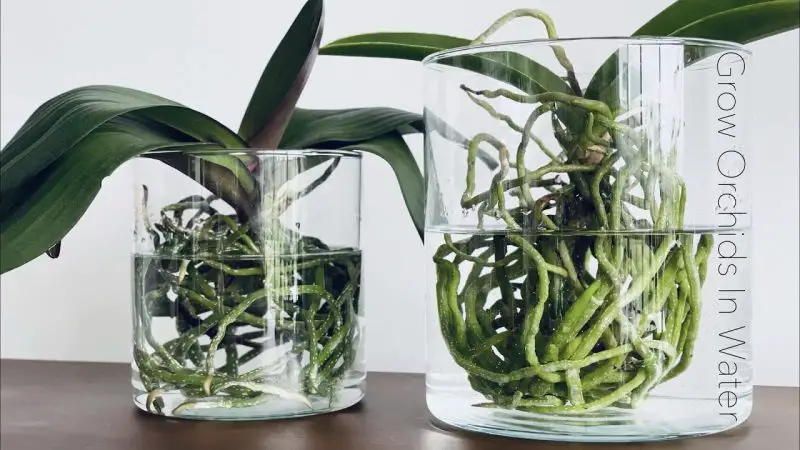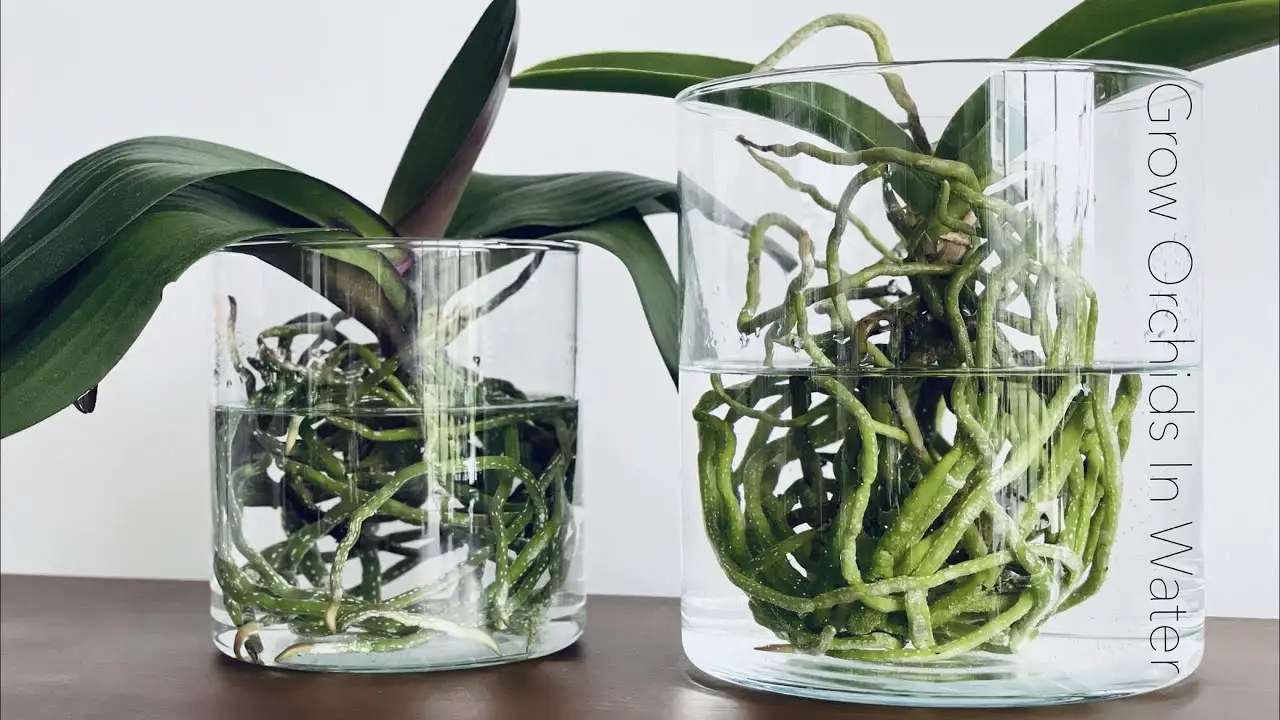
Discover how to take care of orchids in water with our simple guide. Learn the secrets to thriving hydroponic orchids and bring a touch of nature to your home.
How To Take Care Of Orchids In Water Key Takeaways:
- How To Take Care Of Orchids In Water:
- Start with a clean, clear container and fill it with distilled or rainwater.
- Submerge the roots partially, allowing the tips to be in contact with water.
- Change the water weekly and ensure the roots have periods of dryness to prevent rot.
- Monitor for healthy root and leaf growth.
Ever wondered how to take care of orchids in water? You’re in the right place!
Ditch the soil and dive into the world of water culture. It’s easier than you think and can give your orchids a new lease on life.
Let’s explore this fascinating method together and watch your orchids flourish!
In a Nutshell: Taking Care Of Orchids In Water
Here is how to take care of orchids in water. What? You didn’t know you can grow orchids in water? No worries here’s how.
- Start with a clean, clear container and fill it with distilled or rainwater.
- Submerge the roots partially, allowing the tips to be in contact with water.
- Change the water weekly and ensure the roots have periods of dryness to prevent rot.
- Monitor for healthy root and leaf growth.
How To Take Care Of Orchids In Water
Water culture is a fascinating method for growing orchids, offering a soil-free alternative that can enhance airflow and reduce common issues like root rot.
This technique involves semi or full-water culture, where the key difference lies in the duration and depth at which the roots are submerged.
To take care of orchids in water, use a transparent container and partially submerge the roots in distilled or rainwater.
Change the water weekly and allow the roots to dry periodically.
Ensure the container provides adequate humidity and observe for signs of healthy growth.
Growing Orchids In Water Culture – Hydroponic Orchids
Hydroponic orchids thrive in clear containers that allow for easy root observation and maintain optimal humidity levels.
Whether you opt for a pebble-based setup or direct water contact, regular water changes are crucial to prevent bacterial growth and ensure a healthy environment for your orchids.
How To Grow Orchids Without Soil Tips
For successful water culture, start with a clean, clear jar or vase and thoroughly remove any potting mix or moss from the roots.
Use rainwater, distilled, or reverse osmosis water to avoid harmful chemicals and minerals.
Patience is key, as orchids may take time to adjust to hydroponic growth.
How Long Can Orchids Stay In Water?
There’s no one-size-fits-all answer, but a common approach is to partially submerge the roots and change the water weekly.
Some prefer a cycle of 2 days in water followed by 5 days of drying.
Experiment to find what works best for your orchid’s moisture preferences.
Growing Orchids In Water Culture – Hydroponic Orchids
Here is a short video that shows both methods of growing orchids in water.

There are some people who just put some pebbles in their jar and leave the roots just above or barely touching the water.
All they do is change the water weekly. If you are not sure what the best way is you can experiment a bit. Just don’t try it on an orchid you are really attached to.
Water culture is a method for growing orchids in water. There are a few different ways to do this and they are semi or full-water culture.
How To Take Care Of Orchids In Water
Orchids have a reputation for being finicky so combining growing orchids with hydroponics may seem like a risky proposition.
However, often orchids run into problems in potting media because it can restrict airflow.
And it might not give roots a chance to dry out enough to stay healthy. Switching to water culture can help solve these problems.
But basically what varies is how long and how deep you keep the roots. The two main techniques are full and semi-water culture.
It is important to note full water culture does not mean keeping the roots fully in water.
All methods of growing orchids in water rely on some time when the roots are allowed to dry off.
How To Grow Orchids Without Soil Tips
If you want to grow orchids without soil there are a few things you will need to do.
This method works best for epiphytic orchids. In most cases that is what you will have. If it has aerial roots chances are it is an epiphyte.
They generally don’t grow in much media and the media they do grow in can cause problems.
You will need a clear jar or vase to hold your orchid. You want to be able to see your roots.
If you use a container that slightly narrows at the top this is also a good thing.
The jar will maintain a good level of humidity for the roots from the evaporating water. This is why water culture works so well.
This technique really works best for a new orchid you just bought. They likely will just be wrapped in sphagnum moss.
First, you will need to get all potting mix, moss, or bark off your roots. This can be time-consuming if the plant has been potted for a while.
If you leave this stuff on it will rot in your container and could cause bad bacterial growth. You want your water and your roots to be clean.
So gently wash your orchid roots off under a faucet to get everything off them. Make sure the water is lukewarm, not too hot or cold.
Check your orchid for root rot. If you find roots that are soft or squishy you will want to cut them back to healthy tissue or remove them entirely if there is none.
Orchids prefer a slightly acidic pH and if you use tap water it may be too alkaline and have chemicals or minerals you don’t want in it.
So it is best to use rainwater or distilled or reverse osmosis water for your orchid. You can add a bit of balanced fertilizer to this water.
Orchids are not fast growers so be prepared for your plant to take some time to adjust to being grown hydroponically.
Some users of water culture leave their plant roots partly covered in water and they change the water weekly.
Others use a cycle of 2 days in water and a dry period of 5 days.
There really is no right way to do it the important thing is that the roots are exposed to air and don’t remain totally immersed.
Some cover the roots about 1/3 to 1/2 way up the plant and some only put the tips in water or set the tips on top of some pebbles where they can wick water.
Personally, I think that just keeping the lowest root tips wet and changing water weekly will work better than remembering to provide a 2 day wet and 5 day dry cycle.
You can experiment and see what works best for your orchid because some may prefer more moisture than others.
FAQ Section
Q. Can all orchids be grown in water culture?
A. While most epiphytic orchids are suitable for water culture, it’s important to research your specific orchid type to ensure it’s a good candidate.
Q. How often should I change the water in my orchid’s container?
A. It’s recommended to change the water weekly to prevent bacterial growth and ensure a clean environment for your orchid.
Q. Can I use tap water for my hydroponic orchid?
A. It’s best to avoid tap water due to potential chemicals and minerals. Instead, use rainwater, distilled water, or reverse osmosis water.
Q. How do I know if my orchid is adapting well to water culture?
A. Healthy root growth, vibrant leaves, and the absence of root rot are good indicators that your orchid is thriving in water culture.
How To Take Care Of Orchids In Water Conclusion
Embracing water culture for orchids can be a rewarding experience, offering a unique approach to orchid care.
By understanding the basics of semi and full-water culture, choosing the right container, and maintaining clean water, you can create a thriving environment for your orchids.
Experimentation and patience are key, as each orchid may have different moisture needs.
With the right care, your hydroponic orchids can flourish, adding a touch of beauty and nature to your home.
Growing Orchids In Water Final Thoughts
Many times orchids have problems growing in an orchid potting mix. It can remain wet too long and limit air circulation.
It also can decompose over time and expose orchid roots to bad bacteria. So it is not uncommon to repot orchids regularly.
Growing orchids in water might seem crazy at first but airflow is improved and humidity is provided at the same time.
Root rot can be a problem for potted orchids but can be eliminated using water culture.
Most epiphytic orchids do not grow in any media at all naturally.
You don’t need to repot your orchids with water culture. Changing water weekly is much easier to do.
So if you have an orchid that is not doing well in a pot or want to get a new orchid off to a good start give growing orchids in water culture a try.
Read more: Growing Orchids In Hydroponics: Tips and Tricks
More info on water culture orchids here
This post contains affiliate links.

